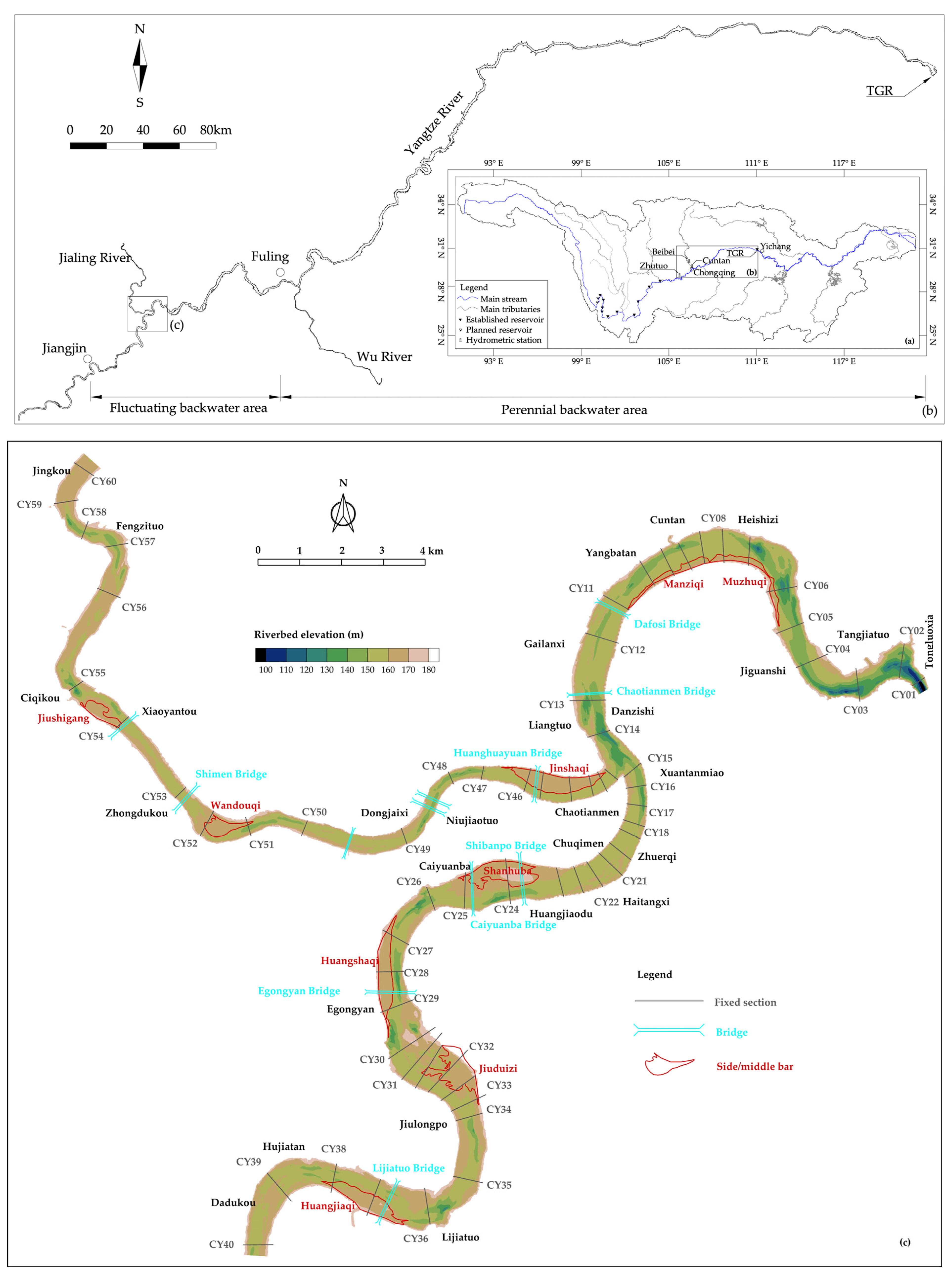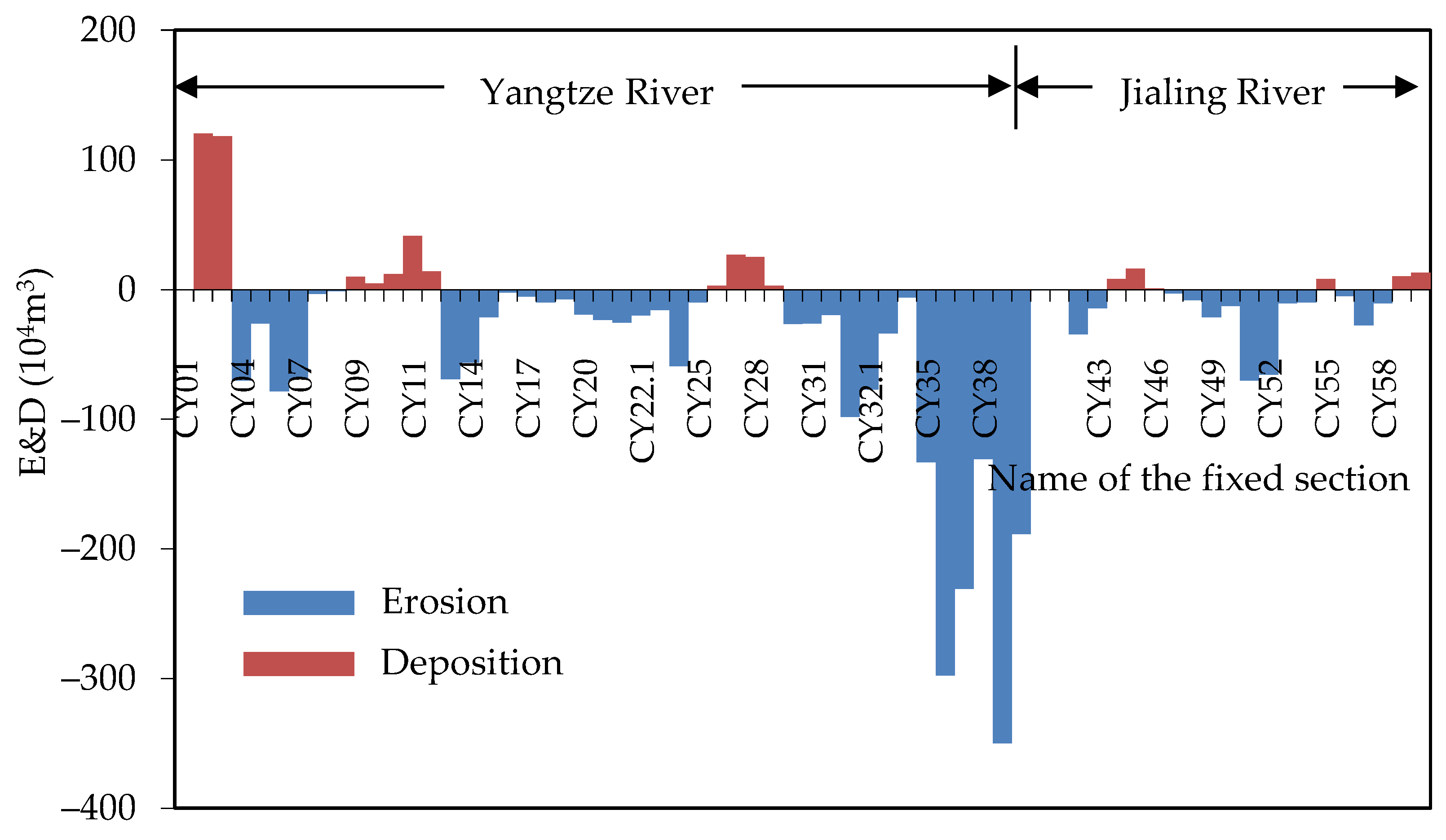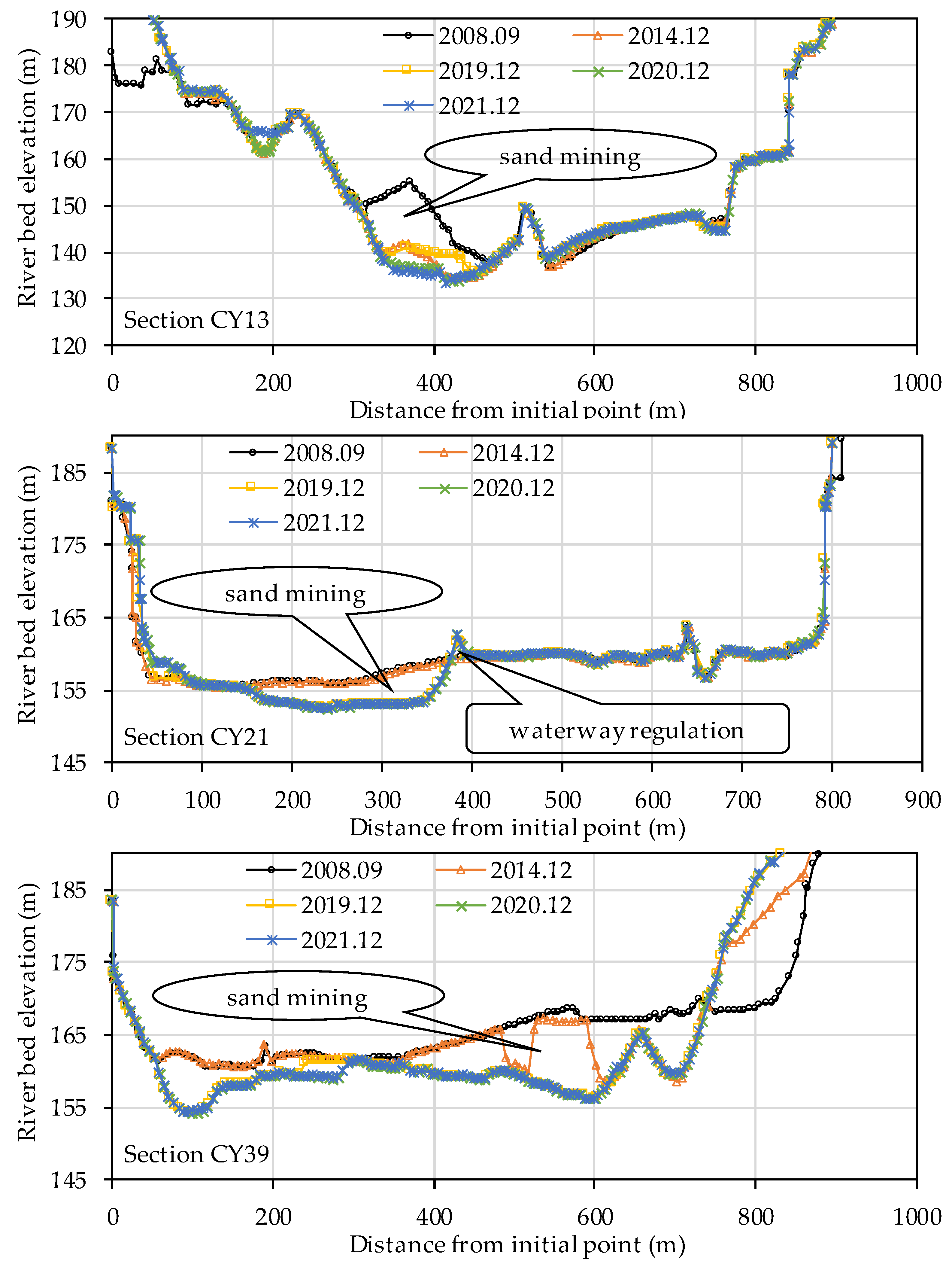Sedimentation Characteristics of the Fluctuating Backwater Area at the Tail of Cascade Reservoirs: A Case Study of the Three Gorges Reservoir
Abstract
:1. Introduction
2. Materials and Methods
2.1. Study Area
2.2. Data
2.3. Method
3. Results
3.1. Volume of Sedimentation
3.2. Plane Changes of Shorelines and Sand Bars


3.3. Plane Change of Pools

3.4. Changes in the Thalweg
3.5. Siltation Distribution

4. Discussion
4.1. Impact of Income Flow and Sediment
4.1.1. Total E&D
4.1.2. Process
4.1.3. Discharge Ratio of the Main Streams of the Yangtze and Jialing Rivers
4.2. Impact of the TGR

4.3. Impact of Human Activities
5. Conclusions
Author Contributions
Funding
Data Availability Statement
Conflicts of Interest
References
- Lu, X.; Huang, E.; Wang, S.; Zhao, X.; Guan, X. Bed-load Sediment Transport in Fluctuating Backwater Area of a Steep Slope Reach. Adv. Eng. Sci. 2018, 50, 89–95. [Google Scholar] [CrossRef]
- Zhang, R.; Wu, B.; Liu, S. Cause of Sediment Problems in Flood Seasons of the Niulan River-Dian Lake Water Diversion Project. J. Basic Sci. Eng. 2020, 28, 1–17. [Google Scholar] [CrossRef]
- Deng, Z. Pebble movement law and channel regulation countermeasures in Shangluoqi reach of Three Gorges Reservoir. Port Waterw. Eng. 2023, 120–126. [Google Scholar] [CrossRef]
- Su, L. Riverbed evolution and waterway regulation scheme of Guangyangba reach in fluctuating backwater area of the Three Gorges Reservoir. Port Waterw. Eng. 2023, 149–154. [Google Scholar] [CrossRef]
- Xia, N.; Xiao, Y.; Hu, X.; Deng, J.; Li, D. Sand mining distribution in fluctuating backwater area of Three Gorges Reservoir. Port Waterw. Eng. 2023, 151–156. [Google Scholar] [CrossRef]
- Liu, M.; Zeng, L.; Wu, L.; Zhu, C.; Abi, E. Effect of periodic water-sediment laden flow on damage for steel piles. Front. Environ. Sci. 2022, 10, 971786. [Google Scholar] [CrossRef]
- Xu, G.; Wang, L.; Yang, S.; Yang, W.; Peng, Y.; Sun, Z. Spatial Distribution and Habitat Characteristics of Fish Swarm in Fluctuating Backwater Zone of Three Gorges Reservoir in Impoundment Period. J. Yangtze River Sci. Res. Inst. 2021, 38, 46–52. [Google Scholar] [CrossRef]
- Yang, S.; Xu, G.; Wang, L.; Yang, W.; Xiao, Y.; Li, W.; Hu, J. Field-derived relationships between fish habitat distribution and flow-sediment conditions in fluctuating backwater zone of the Three Gorges Reservoir. Ecol. Inform. 2021, 62, 101273. [Google Scholar] [CrossRef]
- Xiao, Y.; Deng, J.; Yang, S.; Hu, J.; Wang, L.; Li, W. Study on the spawning habitat suitability of four major Chinese carps in the fluctuating backwater area of the Three Gorges Reservoir. Ecol. Indic. 2022, 143, 109314. [Google Scholar] [CrossRef]
- Jianjun, Z.; Cao, H.; Man, Z. Reducing Deposition in TGP Reservoir by Dredging Coarse Sediment. Sci. Technol. Rev. 2010, 28, 28–36. [Google Scholar]
- Hu, C.; Fang, C. Research on sediment problem solutions for the Three Gorges Project and it operational effects. Sci. Sin. Technol. 2017, 47, 832–844. [Google Scholar] [CrossRef]
- Lu, Y.; Zuo, L.; Ji, R.; Liu, H. Deposition and erosion in the fluctuating backwater reach of the Three Gorges Project after upstream reservoir adjustment. Int. J. Sediment Res. 2010, 25, 64–80. [Google Scholar] [CrossRef]
- Tang, X.; Tong, S.; Huang, G.; Xu, G.; Li, X.; Lei, K.; Yao, S. Characteristics of sedimentation and channel adjustment linked to the Three Gorges Reservoir. Int. J. Sediment Res. 2021, 36, 177–189. [Google Scholar] [CrossRef]
- Hu, J.; Yang, S.; Wang, X. Sedimentation in Yangtze River above Three Gorges Project since 2003. J. Sediment Res. 2013, 1, 39–44. [Google Scholar] [CrossRef]
- Li, W.; Yang, S.; Fu, X.; Xiao, Y. Sedimentation characteristics in the Three Gorges Reservoir during the initial operation stage. Adv. Water Sci. 2015, 26, 676–685. [Google Scholar] [CrossRef]
- Peng, W.; Liu, D.; Liu, T.; Wang, X. Analyses on erosion and deposition characteristics of the river reach in Chongqing City. J. Sediment Res. 2005, 6, 44–50. [Google Scholar] [CrossRef]
- Xujing, Z.; Dewei, M.U.; Shiqiang, Z. Sediment Aggregation and Regulation for Chongqing Reach of the Fluctuating Backwater District in Three Georges Reservoir. J. Chongqing Jianzhu Univ. 2006, 28, 13–17. [Google Scholar] [CrossRef]
- Liu, J.; Yang, S.; Shen, Y. Impact of runoff and sediment from the Upper Yangtze River on deposition in the Three Gorges Reservoir. J. Sediment Res. 2019, 44, 33–39. [Google Scholar] [CrossRef]
- Ren, S.; Liu, L. Sediment deposition and countermeasures in the Three Gorges Reservoir. J. Sediment Res. 2019, 44, 40–45. [Google Scholar] [CrossRef]
- Li, W.; Ma, H.; Yang, S.; Yang, W.; Song, C. Sedimentation and One Dimensional Simulation of Fine Sediment in the Three Gorges Reservoir. J. Basic Sci. Eng. 2021, 29, 251–260. [Google Scholar] [CrossRef]
- Li, W.; Li, N.; Yang, S.; Wang, T. Analysis of the sedimentation in the Three Gorges Reservoir based on the sediment carrying capacity. Adv. Water Sci. 2016, 27, 726–734. [Google Scholar] [CrossRef]
- Li, W.; Yang, S.; Xiao, Y.; Fu, X.; Hu, J.; Wang, T. Rate and Distribution of Sedimentation in the Three Gorges Reservoir, Upper Yangtze River. J. Hydraul. Eng. 2018, 144, 05018006. [Google Scholar] [CrossRef]
- Tang, X.; Tong, S.; Xu, G.; Huang, G.; Wang, T. Delayed response of sedimentation in the flood seasons to the pool level of the Three Gorges Reservoir. Adv. Water Sci. 2019, 30, 528–536. [Google Scholar] [CrossRef]
- Li, X.; Ren, J.; Xu, Q.; Yuan, J.; Zhang, W. Impact of cascade reservoirs on the delayed response behaviour of sedimentation in the Three Gorges Reservoir. J. Geogr. Sci. 2023, 33, 576–598. [Google Scholar] [CrossRef]
- Zhu, L.; Xu, Q.; Zhang, O.; Yang, Y.; Wang, W. Sedimentation at estuary of 66 tributaries in the Three Gorges Reservoir. Sci. Sin. Technol. 2019, 49, 552–564. [Google Scholar] [CrossRef]
- Liu, S.; Li, D.; Liu, D.; Zhang, X.; Wang, Z. Characteristics of sedimentation and sediment trapping efficiency in the Three Gorges Reservoir, China. Catena 2022, 208, 105715. [Google Scholar] [CrossRef]
- Wang, B.-Y.; Yan, D.-C.; Wen, A.-B.; Chen, J.-C. Influencing factors of sediment deposition and their spatial variability in riparian zone of the Three Gorges Reservoir, China. J. Mt. Sci. 2016, 13, 1387–1396. [Google Scholar] [CrossRef]
- Yang, Y.; Chen, L.; Huang, J.; Ping, Y.; Liu, T. Study of sediment silting-scouring in Jialing-Yangtze confluence reach during 175 m experimental impoundment period. Eng. J. Wuhan Univ. 2017, 50, 31–36. [Google Scholar] [CrossRef]
- Lei, Y. Study on overall sediment erosion and sedimentation in the fluctuating backwater area of the Three Gorges Reservoir. Yangtze River 2018, 49, 1–5. [Google Scholar] [CrossRef]
- Liu, S.; Zhang, X.; Huang, J. Analysis on recent variation of transport characteristics of gravel bed-load into Three Gorges Reservoir and its impact. Water Resour. Hydropower Eng. 2018, 49, 82–89. [Google Scholar] [CrossRef]
- Zhu, L.; Ge, H.; Dong, B.; Yang, C. Control index of sediment reduction dispatching in Chongqing reach after the storage level of TGR reaching 175 m. Acta Geogr. Sin. 2021, 76, 114–126. [Google Scholar] [CrossRef]
- Ge, H.; Deng, C. 2D Hydraulic modelling of the main urban area of Chongqing, Part 2: Model validation and application. In Proceedings of the 4th International Workshop on Renewable Energy and Development (IWRED), Electr Network, Sanya, China, 24–26 April 2020; IOP: Bristol, UK, 2020. [Google Scholar]
- Luo, M.; Yu, H.; Huang, E.; Ding, R.; Lu, X. Two-Dimensional Numerical Simulation Study on Bed-Load Transport in the Fluctuating Backwater Area: A Case-Study Reservoir in China. Water 2018, 10, 1425. [Google Scholar] [CrossRef]
- Ren, S.; Zhang, B.; Wang, W.-J.; Yuan, Y.; Guo, C. Sedimentation and its response to management strategies of the Three Gorges Reservoir, Yangtze River, China. Catena 2021, 199, 105096. [Google Scholar] [CrossRef]
- Chen, P.; Deng, J.; Tan, G.; Lu, J.; Jin, Z.; Zhou, Y.; Shu, C.; Feng, Z.; Tang, R.; Lve, Y.; et al. Prediction research on sedimentation balance of Three Gorges Reservoir under new conditions of water and sediment. Sci. Rep. 2021, 11, 19005. [Google Scholar] [CrossRef] [PubMed]
- Yang, C.; Deng, J.; Qi, Y.; Wang, Y.; Lin, J. Study on Long-term Impact of Small and Medium-sized Floods Regulation on Sedimentation of the Three Gorges Reservoir. Water Resour. Power 2020, 38, 34–37. [Google Scholar]
- Pan, Q. Review of sediment research in Three Gorges Project in recent 60 years. Yangtze River 2017, 48, 18–22. [Google Scholar] [CrossRef]
- Bureau, C.W.R. Yangtze River. Available online: http://slj.cq.gov.cn/ztzl_250/hzzjsst/tzgg_24017/201707/t20170705_6080714_wap.html (accessed on 5 July 2023).
- Ge, H.; Zhu, L.; Deng, C.; Jiang, L.; Long, R. Decadal Hydro-Morphodynamic Evolution of a Sandy Meander Bend Downstream of the Three Gorges Dam and Impact on Waterway Navigation. Water 2022, 14, 19. [Google Scholar] [CrossRef]
- Lu, Y.; Wang, Y.; Cao, L.; Zhang, Q.; Zhao, D. Fluvial Process of Chongqing Segment of Wujiang River and Its Impacts on Navigation. J. Yangtze River Sci. Res. Inst. 2023, 40, 186–191. [Google Scholar] [CrossRef]
- Huang, R.; Shu, C.; Tang, G. Preliminary Study on Transportation Characteristics of Sediment Concentration Peak of the Three Gorges Reservoir in Flood Season. J. Basic Sci. Eng. 2019, 27, 1202–1210. [Google Scholar] [CrossRef]
- Zhang, F. Influence of confluence ratio on water flow and sediment characteristics in Chongqing of the Yangtze River. J. Waterw. Harb. 2023, 44, 352–361. [Google Scholar] [CrossRef]
- Xiao, Y.; Zhang, S.; Yang, S.; Li, W. Distribution of sand excavation area and simulation of recovery ability for destroyed gravel shoals in upstream of the Yangtze River. Port Waterw. Eng. 2020, 127–131+154. [Google Scholar] [CrossRef]
- Chen, X.; Zhang, X. Regulation of the Chongqing section of the Yangtze River in the fluctuating backwater area of the Three Gorges Reservoir. China Water Transp. 2008, 40–41+43. [Google Scholar] [CrossRef]
- Fan, S.; Zhu, D.; He, Y.; Li, J. Stepped navigation regulation structures design of Hujiatan beach in fluctuating backwater area of the Three Gorges reservoir. Port Waterw. Eng. 2016, 134–138+157. [Google Scholar] [CrossRef]







| Type | Period | Measurements | Source |
|---|---|---|---|
| Fixed-section terrain | 2008–2009 | 62, June to November, once a month | Hydrological Bureau of the Yangtze River Water Conservancy Commission |
| 2010–2015 | 65, decreasing from 16 to 9 times per year | ||
| 2016–2022 | 65, June to October, once a month | ||
| Topographic terrain (Entire river section) | 2008–2009 | July, December | |
| 2016–2022 | December | ||
| Topographic terrain (Key river sections) | 2010–2015 | July, December | |
| Flow discharge | 2008–2022 | Daily average |
| Time Interval | Main Stream of the Yangtze River | Jialing River | Whole | Notes | |
|---|---|---|---|---|---|
| Below Chaotianmen | Above Chaotianmen | ||||
| September 2008~December 2008 | −37.4 | −24.6 | −66.8 | −128.8 | Storage period in 2008 |
| December 2008~June 2009 | −33.5 | −73.7 | −18.2 | −125.4 | Decline period in 2009 |
| June 2009~September 2009 | −59.9 | 42.6 | 57 | 39.7 | Flood season of 2009 |
| September 2009~November 2009 | 41.6 | −47.1 | −72.2 | −77.7 | Storage period in 2009 |
| November 2009~June 2010 | 16.1 | 70.4 | 94.3 | 180.8 | Decline period in 2010 |
| June 2010~September 2010 | 70.9 | 43 | −154.3 | −40.4 | Flood season in 2010 |
| September 2010~December 2010 | 43.8 | 22 | 139.3 | 205.1 | Storage period in 2010 |
| December 2010~June 2011 | −113.6 | −84.8 | −65.9 | −264.3 | Decline period in 2011 |
| June 2011~September 2011 | −28.9 | 29.7 | 16.8 | 17.6 | Flood season in 2011 |
| September 2011~December 2011 | 12.5 | 53.8 | 19.4 | 85.7 | Storage period in 2011 |
| December 2011~June 2012 | −51.4 | −178.1 | −72.6 | −302.1 | Decline period in 2012 |
| June 2012~September 2012 | 166.7 | 30.8 | 91.8 | 289.3 | Flood season in 2012 |
| September 2012~October 2012 | −21.2 | −105.6 | 18.9 | −107.9 | Storage period in 2012 |
| October 2012~June 2013 | 0.4 | −273 | −57 | −329.6 | Decline period in 2013 |
| June 2013~September 2013 | −57.5 | −28.6 | −53.8 | −139.9 | Flood season in 2013 |
| September 2013~December 2013 | −47.6 | −137.3 | 8.1 | −176.8 | Storage period in 2013 |
| December 2013~June 2014 | −80.4 | −151.2 | −78 | −309.6 | Decline period in 2014 |
| June 2014~September 2014 | 108 | 40.2 | −3.3 | 144.9 | Flood season in 2014 |
| September 2014~December 2014 | −89.2 | −238.3 | −7 | −334.5 | Storage period in 2014 |
| December 2014~June 2015 | −37.3 | −160.2 | −53.7 | −251.2 | Decline period in 2015 |
| June 2015~September 2015 | 120.7 | 71.3 | 84.6 | 276.6 | Flood season in 2015 |
| September 2015~December 2015 | −55.1 | −106.8 | −46.6 | −208.5 | Storage period in 2015 |
| December 2015~June 2016 | 67.5 | −21.1 | −43.8 | 2.6 | Decline period in 2016 |
| June 2016~October 2016 | −100.5 | −31 | −1.4 | −132.9 | Flood season in 2016 |
| October 2016~December 2016 | −42.6 | 54 | 22.6 | 34 | Storage period in 2016 |
| December 2016~June 2017 | 25.6 | −112.8 | −17.2 | −104.4 | Decline period in 2017 |
| June 2017~October 2017 | −8.2 | −82.3 | 28.8 | −61.7 | Flood season in 2017 |
| October 2017~December 2017 | 40.4 | 0.1 | −10.4 | 30.1 | Storage period in 2017 |
| December 2017~June 2018 | −37.7 | −164.6 | −41.8 | −244.1 | Decline period in 2018 |
| June 2018~October 2018 | 14.6 | −69.6 | 26.5 | −28.5 | Flood season in 2018 |
| October 2018~December 2018 | −7.7 | −29.1 | 25.4 | −11.4 | Storage period in 2018 |
| December 2018~May 2019 | 2.3 | −101.1 | −40.6 | −139.4 | Decline period in 2019 |
| May 2019~October 2019 | 38 | −67.6 | −24.7 | −54.3 | Flood season in 2019 |
| October 2019~December 2019 | 44.4 | −51.1 | 6.1 | −0.6 | Storage period in 2019 |
| December 2019~May 2020 | 17.9 | 40.8 | 0.7 | 59.4 | Decline period in 2020 |
| May 2020~October 2020 | 48.7 | 148.9 | 118.3 | 315.9 | Flood season in 2020 |
| October 2020~December 2020 | −76.2 | −81.7 | −25 | −182.9 | Storage period in 2020 |
| December 2020~May 2021 | 57.2 | 38.8 | −41.8 | 54.2 | Decline period in 2021 |
| May 2021~October 2021 | −8.3 | 30.1 | 60.8 | 82.6 | Flood season in 2021 |
| October 2021~December 2021 | −11.3 | 2.2 | 26.4 | 17.3 | Storage period in 2021 |
| December 2021~June 2022 | −89.2 | −88.5 | −69.7 | −247.4 | Decline period in 2022 |
| June 2022~December 2022 | 83 | 34.3 | −16 | 101.3 | Flood and storage periods in 2022 |
| September 2008~December 2022 | −74.4 | −1756.8 | −236 | −2067.2 | |
| Section | Average (m) | Maximum | ||
|---|---|---|---|---|
| Value (m) | Location | |||
| Main stream of the Yangtze River | Above Chaotianmen | −1.04 1 | 2.0 | CY34 |
| Below Chaotianmen | −0.07 | 18.3 | CY02 | |
| Jialing River | −0.21 | 4.4 | CY52 | |
Disclaimer/Publisher’s Note: The statements, opinions and data contained in all publications are solely those of the individual author(s) and contributor(s) and not of MDPI and/or the editor(s). MDPI and/or the editor(s) disclaim responsibility for any injury to people or property resulting from any ideas, methods, instructions or products referred to in the content. |
© 2023 by the authors. Licensee MDPI, Basel, Switzerland. This article is an open access article distributed under the terms and conditions of the Creative Commons Attribution (CC BY) license (https://creativecommons.org/licenses/by/4.0/).
Share and Cite
Li, J.; Ge, H.; Ping, Y.; Dong, X.; Zhu, L.; Ma, Y. Sedimentation Characteristics of the Fluctuating Backwater Area at the Tail of Cascade Reservoirs: A Case Study of the Three Gorges Reservoir. Water 2023, 15, 4011. https://doi.org/10.3390/w15224011
Li J, Ge H, Ping Y, Dong X, Zhu L, Ma Y. Sedimentation Characteristics of the Fluctuating Backwater Area at the Tail of Cascade Reservoirs: A Case Study of the Three Gorges Reservoir. Water. 2023; 15(22):4011. https://doi.org/10.3390/w15224011
Chicago/Turabian StyleLi, Jun, Hua Ge, Yanrong Ping, Xianyong Dong, Lingling Zhu, and Yaochang Ma. 2023. "Sedimentation Characteristics of the Fluctuating Backwater Area at the Tail of Cascade Reservoirs: A Case Study of the Three Gorges Reservoir" Water 15, no. 22: 4011. https://doi.org/10.3390/w15224011
APA StyleLi, J., Ge, H., Ping, Y., Dong, X., Zhu, L., & Ma, Y. (2023). Sedimentation Characteristics of the Fluctuating Backwater Area at the Tail of Cascade Reservoirs: A Case Study of the Three Gorges Reservoir. Water, 15(22), 4011. https://doi.org/10.3390/w15224011








